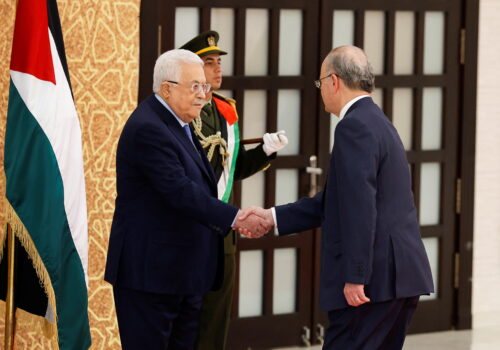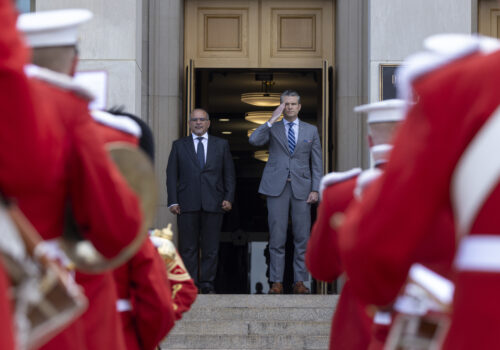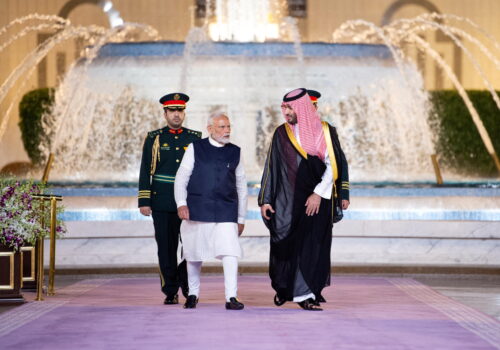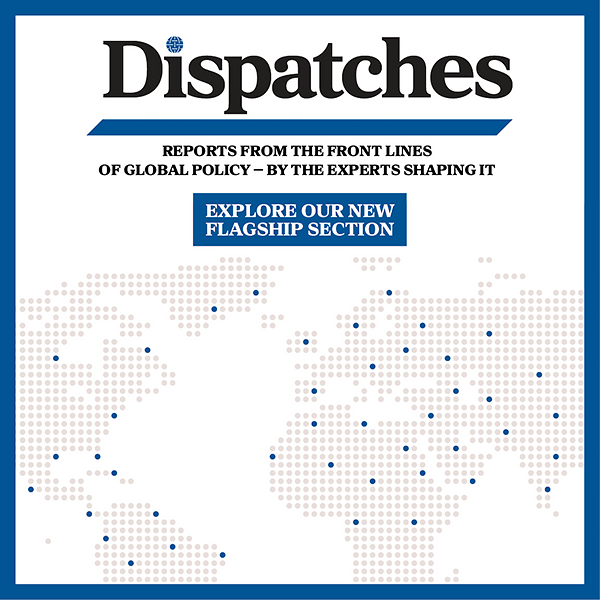What’s needed to unlock the power and promise of IMEC
When economic interests align, new political and security partnerships often follow, and one of the most promising examples of this is the India-Middle East-Europe Economic Corridor (IMEC).
This ambitious project seeks to create a “golden road” linking East and West, not just for trade—but as a model for future regional integration. Israeli Prime Minister Benjamin Netanyahu calls it the “largest cooperation project in our history.”
Announced in 2023 at the G20 summit, IMEC is a rare initiative that has enjoyed strong support from both former US President Joe Biden and President Donald Trump’s administrations. Aiming to connect India to Europe through the Arabian Peninsula and Israel, the multilateral project maintains widespread support, including from the United Arab Emirates (UAE), Saudi Arabia, and India.
SIGN UP FOR THIS WEEK IN THE MIDEAST NEWSLETTER
While the potential of IMEC is immense, there are significant hurdles to its full realization, from geopolitical rivalries to complex infrastructure and differing priorities. To succeed, the initiative must address these challenges proactively by meeting four key conditions.
1. Partnership with the private sector: In order for IMEC to be successful, there must be robust cooperation between the governments and the private sector—both in countries through which the corridor must pass through and at its endpoints in Asia and Europe. Business leaders must be involved not only in executing projects, but also in shaping them. Ports, logistics, manufacturing, and digital service providers all see real commercial value in the corridor. It should be the role of participating governments to help connect markets, share information, and provide risk assurance mechanisms to translate private interest into tangible investments.
2. True economic viability through competition: Real competition along every segment of the corridor is also necessary to ensure economic viability. In order to maintain its attractiveness for diverse private sector actors and to limit single points of failure in the corridor, the IMEC cannot be monopolized by a single port, company, or national carrier. There must be more than one exit to the Mediterranean, in Israel and in other future IMEC signatories, and more than one logistics provider at every stage. Competition is fundamental to guarantee fair pricing and prevent excessive profits from accumulating in the hands of monopolies, and promote efficiencies that will be necessary for transshipment via IMEC to be economically competitive with other routes, like the Suez Canal.
3. Supporting trade along the corridor: IMEC must be two-way and multi-nodal, allowing goods to move from multiple directions, with trade occurring among all the countries along the corridor, not just the endpoints. While some products will be shipped from India to the UAE, where they will be exchanged for goods destined for Jordan, others may start in Saudi Arabia and end in Israel—or vice versa. There are practical steps policymakers can take to facilitate trade along the corridor, including measures to further reduce logistics costs and transportation times. One important example is digital customs systems integration, building on the example of the Master Application for International Trade and Regulatory Interface (MAITRI) platform, which is helping underpin the India-UAE Virtual Trade Corridor, so that regulatory processes are seamless across borders and goods can be transshipped with minimal delays. Customs authorities in every country must speak the same digital language and harmonize their approaches—particularly along sensitive borders—to minimize the impact of the intrinsic challenges associated with multimodal shipping.
4. Creative solutions to areas of competition: Policymakers will need to operationalize economic incentives to create shared value and bring in users. Egypt, for example, has expressed concerns that IMEC could divert traffic from the Suez Canal, which is a critical source of national revenue that underpins both Egyptian foreign reserve currency and its national economy. While some have proposed routing goods through Alexandria as a compromise, such solutions are not economically sustainable. A creative solution to Egypt’s concerns could be to leverage the creation of a Qualified Industrial Zone (QIZ) among Israel, Egypt, and the European Union to help facilitate trade between Egypt and other IMEC countries. This QIZ could be modeled after the successful QIZ between Egypt, Israel, and the United States. In this model, products produced with 10 percent Israeli and 90 percent Egyptian content would be eligible for tariff-free entry into the European market. Such a framework could mitigate Cairo’s concerns while creating jobs, attracting investment, and fostering deeper regional cooperation.
An ambitious agenda and an Abraham Accords foundation
IMEC has the potential to do far more than transport goods. It can be a channel for tourism, digital communication, energy transmission, and cultural exchange. It can become a symbol, not just of what the region can trade and ship, but of what it can become when we break down barriers, align our interests, and work together to create something richer than the sum of its parts.
The potential has already been demonstrated through the historic momentum behind the landmark Abraham Accords deals, and it is important to recognize how normalization has transformed the regional economic calculus and delivered real, tangible value for the signatories.

The robust engagement and strategic partnership between Israel and the UAE offers a prime example. Since normalizing relations and signing the UAE-Israel Comprehensive Economic Partnership Agreement (CEPA), Israel-UAE Bilateral trade of goods (excluding government-to-government and software and services) from 2021 to 2024 reached more than $10 billion. In 2024 alone, trade between the two burgeoning partners reached a value of $3.248 billion, with almost two million Israelis and Emiratis traveling on tourism and business visas over the same period. The numbers show the direct value of regional normalization both in economic terms and direct person-to-person engagements. Even today, under the lingering clouds of regional conflict, the direction is clear. Between 2023 and 2024, trade between the two countries grew by an additional 11 percent.
As President of the UAE, H.H. Sheikh Mohammed bin Zayed Al Nahyan said, our cooperation is “a racing car that drives forward and has no reverse gear.”
In the Middle East, skepticism often precedes transformation. Less than a decade ago, diplomatic ties between Israel and the UAE seemed unlikely. Today, in that partnership, we are witnessing one of the most successful examples of peaceful regional integration. That success is not theoretical—it is tangible, measurable, and inspiring others to ask: Why not us?
We must not be afraid to dream, nor forget that achieving a truly transformative economic corridor is within reach. It is ambitious, but it is also aligned with both public and private interests across the region. Beyond that, IMEC is a symbol for the hope that a more prosperous, stable, and interconnected future is possible for the Middle East. It is time to press forward by reconvening the IMEC signatories to make a renewed commitment to the corridor in 2025.
Amir Hayek is a nonresident senior fellow in the N7 Initiative, a partnership between the Atlantic Council and Jeffrey M. Talpins Foundation. Hayek served as the first Israeli ambassador to the United Arab Emirates from 2021 to 2024, working to strengthen diplomatic and economic ties between the two countries after formalizing relations under the Abraham Accords.
Further reading
Tue, Aug 12, 2025
There is a way forward for a two-state solution, if Palestinian leaders embrace the Abraham Accords
MENASource By
By collaborating with regional partners and taking incremental steps within the framework of the Abraham Accords, the PA can move closer to realizing a Palestinian state.
Mon, Aug 11, 2025
The United Kingdom has joined C-SIPA. Who will be next?
MENASource By Cassidy McGoldrick
To fully realize the regional security architecture that the United States and Bahrain envision, policymakers will need to expand C-SIPA within the Middle East region.
Tue, Jun 3, 2025
India-Gulf relations are muted—but mobilizing
MENASource By Jonathan Fulton
The depth of Indian-Gulf relations creates a strong foundation for increased India-Middle East integration over the coming decades.
Image: Israeli and Indian national flags fly at Haifa Port, which is to be sold to India's Adani Ports and local partner Gadot, in Haifa, Israel July 24, 2022. REUTERS/Amir Cohen



